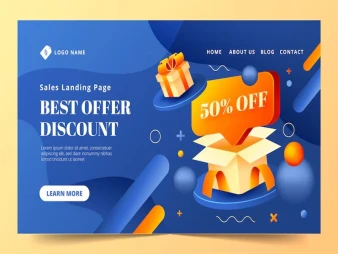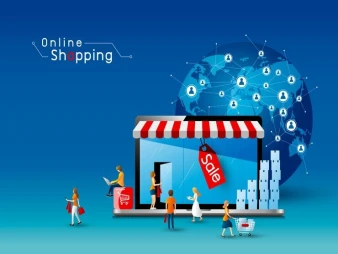Free support 24/7
Free support 24/7

How does visual marketing help increase your online store sales?
introduction
Visual marketing is the art and science of using visual elements to capture customers' attention and motivate them to buy. It includes designing and planning the online store, presenting the products in an attractive and creative way, and using colors, images, videos, fonts, symbols and other visual means to highlight the advantages and characteristics of the products and create an enjoyable and satisfying shopping experience for customers1.
Visual marketing is of great importance in electronic commerce, as it helps in overcoming some of the challenges facing electronic stores, such as the lack of sensory interaction between the customer and the product, the inability of the customer to try or test the product before purchasing, or the increase in competition between different electronic stores 2. It also contributes to achieving some marketing goals, such as increasing traffic to the store, increasing the conversion rate from visitor to buyer, increasing the value of the shopping cart, and increasing the loyalty and return rate3.
In this article, we will review some methods and ideas that can be used to implement visual marketing in your online store, as well as some examples and tools that can be used to create attractive visual elements.
Store design
The first step in visual marketing is to design the store professionally and attractively, expressing your brand identity, satisfying the taste of your target audience, and befitting your business. The store design should be easy to navigate, fast to load, and compatible with all screen sizes. It should also contain important design elements, such as:
The logo and name of the store: They must be clear and distinct, and reflect the message and values that you want to convey to customers.
List of sections: It should be arranged and organized logically, and contain the main and sub-categories of the products you sell, and make it easier for the customer to reach the product he is looking for.
The search bar: It should be located in a prominent place, and it allows the customer to enter keywords to search for the products they want, and it displays relevant and accurate results.
Slideshow: It should be on the home page of the store, showing animated images of the most important products, offers or news that you want to highlight to customers, and containing links that lead them to relevant product pages or sections.
Product pages: They should be detailed and informative, contain high-quality images of the product from different angles, an accurate description of the features and advantages of the product, price and discount if any, shipping and payment options, the button to add to cart or buy now, and the opinions and ratings of previous customers.
Shopping Cart: It should be visible and easy to access, showing the customer a list of the products they have selected, the total value of the purchases, a button to complete the order, and options to modify, remove or continue shopping.
The payment page: It must be simple and secure, and it asks the customer for his personal data and delivery address, and offers him multiple options for payment methods, whether by credit card or using electronic payment services such as Paypal or cash on receipt.
Order confirmation page: This should appear to the customer after the payment has been completed, thanking them for their order, giving them a number to track the status of their order, and reminding them of exchange policies
View products
The second step in visual marketing is to display products in an attractive and creative way, which attracts customers' attention and motivates them to buy. The display of products must be consistent with the store's design, logically organized, and updated periodically. It should also contain important display elements, such as:
Product images: They must be of high quality and accuracy, showing the product from different angles, highlighting its details and characteristics, and reflecting its true colors and sizes. Also, product images must be uniform in background, lighting, and angle, to give a professional and coordinated look to the store. Some free tools can be used to create attractive product images, such as [Canva], [Pixlr] or [Fotor].
Product videos: They can be more effective than photos in showing the different features, benefits and uses of products, especially those that need explanation, clarification or demonstration. It can also help remove some reservations or doubts that a customer might have before making a purchase. Some free tools can be used to create attractive product videos, such as [Animoto], [Powtoon], or [Lumen5].
Graphics and icons: They can help add an artistic and creative touch to the presentation of products, especially those used to show some characteristics, comparisons or statistics related to products. It can also help simplify and clarify some concepts or ideas that may be complex or unclear. Some free tools can be used to create attractive product graphics and icons, such as [Piktochart], [Flaticon], or [GraphicSprings].
Badges and banners: These can help highlight certain offers, discounts, or benefits you offer to customers, such as free shipping, warranty, returns, or cash on delivery. It can also help establish a relationship of trust and credibility between you and your clients. Some free tools can be used to create attractive banners and badges for products, such as [Bannersnack], [Bannerflow], or [Visme].
Use of colours
The third step in visual marketing is to use colors effectively and thoughtfully, to create a certain atmosphere and mood for the store, to arouse certain feelings and emotions for customers, and to achieve some marketing goals. Colors must be consistent and balanced, consistent with your brand identity, satisfy the taste of your target audience, and suit your business. You should also use colors strategically, to highlight some of the important elements in the store, such as the store logo, the purchase button, or sales offers. Some free tools can be used to choose and apply the best color combinations for the store, such as [Coolors], [Adobe Color] or [Paletton].
Use visual stories
You can use a combination of photos or videos to tell a specific story about your products or brand
It arouses the curiosity and interest of customers, and creates an emotional relationship with them. You can display these stories on the store home page, on product pages, or on content pages. An example of this is Zappos, which features visual stories about customers' experiences with their products.
Use of influencer marketing: You can use photos or videos of influential people in your field or in your target audience, who are using or promoting your products, to show the value, quality and popularity of your products, and to increase the trust and loyalty of customers. You can display these photos or videos on product pages or on social media pages. An example of this is [Gymshark], which features pictures of famous athletes and coaches wearing their clothes.
Use local marketing
You can use images or videos that reflect the culture, traditions, or celebrations of your target region, to show your respect and sympathy for your local audience, and to increase their sense of belonging and loyalty to your brand. You can view these photos or videos on the store home page or on the content pages. An example of this is [Coca-Cola], which features photos and videos related to holidays and local events in each country.
Use of multiple tests
You can use analytics tools to test and compare the performance of different elements of your store, such as colors, images, titles or buttons, to see what works best with your audience and what leads to more sales. You can use some free tools to run multiple tests, such as [Google Optimize], [Optimizely], or [Visual Website Optimizer].
Use testimonials and success stories
You can use images, videos or texts showing testimonials and success stories of previous customers who have purchased your products and obtained positive results, in order to show the quality and effectiveness of your products, and to increase the trust and satisfaction of existing and potential customers. You can view these testimonials and stories on product pages or on content pages. An example of this is [Amazon], which shows customer ratings and opinions on the products they have purchased.
Use filters and categories
You can use the options to filter and classify products according to different criteria, such as price, size, color, brand, or evaluation, in order to facilitate the customer's search and selection process, to show the diversity and richness of your products, and to increase the opportunity to sell specific products. You can view these filters and categories on section pages or in the search bar. An example of this is the [ASOS] website, which offers multiple options for filtering and categorizing clothing, shoes, and accessories.
These are also some important tips to improve the look of your online store:
Choose a design that matches your brand identity and target audience, and expresses your message and values clearly and distinctly.
Make your store easy to browse and use, and use menus, links and buttons that help the customer access the products and information they are looking for quickly and easily.
Ensure that product images are of high quality and accuracy, show the product from different angles, highlight its details and characteristics, and reflect its true colors and sizes.
Use short, eye-catching videos to show the different features, benefits, and uses of products, especially those that need explanation, demonstration, or demonstration.
Use colors effectively and thoughtfully, to create a certain atmosphere and mood for the store, to evoke certain feelings and emotions for customers, and to achieve some marketing goals. Choose the colors that suit your brand identity, satisfy the taste of your target audience, and suit your business.
Use badges and banners to help highlight certain offers, discounts, or benefits you offer to customers, such as free shipping, warranty, returns, or cash on delivery. Make these badges and banners visible and eye-catching, and don't overdo it.
Make your store content brief and expressive, and don't use unnecessary or vague words or phrases. Write in an easy and simple way, and do not use difficult or complex words. Use catchy titles and short paragraphs, and separate them with spaces or periods. Use graphics or icons to add an artistic and creative touch to your store's content, and don't forget to use keywords that help improve your store's ranking in search results.
In conclusion
Visual marketing is an effective and creative way to increase the sales of your online store, by using attractive and influential visual elements that help attract customers' attention and motivate them to buy. In this article, we learned about some methods and ideas that can be used to implement visual marketing in your online store, as well as some examples and tools that can be used to create attractive visual elements. We hope that this article was useful to you, and that it helped you improve the performance of your online store.

Flash sales are not just a temporary marketing tool. They are a smart tool to quickly drive sales and increase engagement in your store

تعرف على الطريقة الذكية اللي تخليك تستفيد من تجارب عملاءك السابقين في تسويق منتجاتك الجديدة وزيادة المبيعات
You can create your store easily